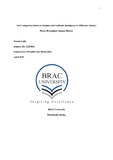| dc.description.abstract | A universal truth about the humans is that they are the best of all creatures, but modern science says that human- made machines are slowly taking over the royal crown of humans. Various arguments have been made using impeccable logics throughout human history supporting both sides of the debate but, eventually, the issue remains unresolved. The idea of robots in fact does not sound as modern as we think, but rather recurs frequently in the ancient religious and scientific texts. I am going to examine three science fictional works of literature which are Frankenstein by Mary Shelly , The Strange Case of Dr. Jekyll and Mr. Hyde by Robert Luis Stevenson and I Robot by Isaac Asimov. This dissertation attempts to find out the superior species among those two and also endeavors to explore all the theories behind those debates that have been going around for a long time by using literary characters. The thesis also sheds light on the ways in which the unique or special features of humans are depicted in terms of humanistic properties. In addition, it explores how literature transposes human abilities on to robots, just as humans are often shown to act in ―non-human‖ or mechanistic ways. This thesis concludes that the literary representations of the ongoing debate sides with the species which has a sense of humanity, regardless of being a human or a robot. | en_US |

